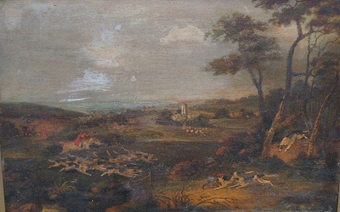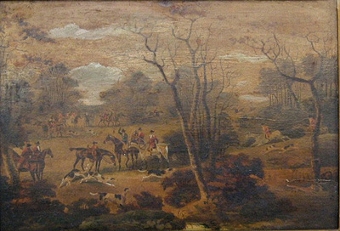Cheddar Gorge is a limestone gorge in the Mendip Hills, near the village of Cheddar in Somerset, England. The gorge is the site of the Cheddar show caves, where Britain''s oldest complete human skeleton, Cheddar Man, estimated to be 9,000 years old, was found in 1903.Older remains from the Upper Late Palaeolithic era (12,000?13,000 years ago) have been found.[2] The caves, produced by the activity of an underground river, contain stalactites and stalagmites. Cheddar Gorge, including the caves and other attractions, has become a tourist destination. In a 2005 poll of Radio Times readers, following its appearance on the 2005 television programme Seven Natural Wonders, Cheddar Gorge was named as the second greatest natural wonder in Britain, surpassed only by Dan yr Ogof caves. The gorge attracts about 500,000 visitors per year. Cheddar is a gorge lying on the southern edge of the Mendip Hills. The maximum depth of the gorge is 137 m (449 ft), with a near-vertical cliff-face to the south, and steep grassy slopes to the north. The B3135 road runs along the bottom of the gorge.
The area is underlain by Black Rock slate, Burrington Oolite and Clifton Down Limestone of the Carboniferous Limestone Series, which contain ooliths and fossil debris, on top of Old Red Sandstone and by Dolomitic Conglomerate of the Keuper. Evidence for Variscan orogeny is seen in the sheared rock and cleaved shales. In many places weathering of these strata has resulted in the formation of immature calcareous soils.[8]
The gorge was formed by meltwater floods during the cold periglacial periods which have occurred over the last 1.2 million years. During the ice ages permafrost blocked the caves with ice and frozen mud and made the limestone impermeable. When this melted during the summers water was forced to flow on the surface, and carved out the gorge.[9] During warmer periods the water flowed underground through the permeable limestone, creating the caves and leaving the gorge dry, so that today much of the gorge has no river until the underground Cheddar Yeo emerges in the lower part from Gough''s Cave. The river is used by Bristol Water, who maintain a series of dams and ponds which supply the nearby Cheddar Reservoir, via a 137-centimetre (54 in) diameter pipe that takes water just upstream of the Rotary Club Sensory Garden, a public park in the gorge opposite Jacob''s Ladder.
The gorge is susceptible to flooding. In the Great Flood of 1968 the flow of water washed large boulders down the gorge and damaging the cafe and entrance to Gough''s Cave, and washing away cars. In the cave itself the flooding lasted for three days. The gorge is part of a Site of Special Scientific Interest now called Cheddar Complex.
The south side of the gorge is owned and administered by the Marquess of Bath''s Longleat Estate. The cliffs on the north side of the gorge are owned by The National Trust. Every year both of the gorge''s owners contribute funds towards the clearance of scrub bush and trees from the area. Longleat Estate has fenced off a large part of its land and has introduced goats, as part of a programme to encourage the biodiversity of the area; the goats were intended to replace the sheep that grazed in the gorge until the 1970s. The National Trust announced in March 2007 that they plan to release a flock of sheep on its side of the gorge for the same purpose, but will first consult local residents and interested parties on whether to fence off the gorge or introduce cattle grids to prevent the sheep from straying. There is already a small flock of feral Soay sheep in the gorge. Other notable species at the gorge include dormice, yellow-necked mice, slow worms and adders and the rare large blue butterfly (Maculinea arion), and small pearl-bordered fritillary (Boloria selene).A wide variety of wild birds can be seen in the gorge including peregrine falcons, buzzards, kestrels, ravens and the Grasshopper Warbler (Locustella naevia).
The flora include chalk grassland-loving species such as marjoram and wild thyme. The Cheddar pink, (Dianthus gratianopolitanus), also known as firewitch, a type of Dianthus only grows in the wild in the gorge. It was once common in the gorge but declined after being picked by collectors. It is also home to unique species of Whitebeam. The nationally rare little robin geranium (purpureum), and Cheddar bedstraw (Galium fleurotii) and the nationally scarce species include slender tare (Vicia tenuissima), dwarf mouse-ear (Cerastium pumilum) and rock stonecrop (Sedum forsteranum) also occur in the gorge. It is one of the very few areas in southern Britain where the lichens Solorina saccata, Squamaria cartilaginea and Caloplaca cirrochroa can be found.
The gorge is also an important site for whitebeams and in 2009 a survey was carried out by botanists from the Welsh National Herbarium as part of a nationwide survey of whitebeams. Among the eight secies identified were three new species previously unknown to science. Nineteen specimens with oval-shaped leaves, were named the "Cheddar whitebeam", Sorbus cheddarensis, fifteen specimens with roundish leaves and greyish brown bark were named the "Twin Cliffs whitebeam", Sorbus eminentoides, and thirteen with long, narrow leaves were named "Gough?s Rock whitebeam", Sorbus rupicoloides. The Cheddar whitebeam, which has evolved as a cross between the common whitebeam and the grey-leaved whitebeam, is unique to the gorge, but its survival is threatened by the goats that were introduced specifically to keep down the growth of new trees and encourage the proliferation of rare plant species such as the Cheddar pink. Cuttings have been taken from the trees to be grafted and grown on at the Welsh National Herbarium.
John Louis Petit was born at Ashton-under-Lyne, Lancashire, son of John Hayes Petit. He was educated at Eton, and contributed to the "Etonian". He was elected to a scholarship at Trinity College Cambridge in 1822, graduated BA in 1823 and MA in 1826, and on 21st June 1850 he was admitted "ad eundem" at Oxford. He took holy orders in 1824, but undertook no parochial work.
Petit showed a taste for sketching in early years. His favourite subject was old churches, and a great part of his life was spent in visiting and sketching them. In 1839 he made his first extensive tour of the continent. The results appeared in his "Remarks on Church Architectire" (1841, 2 vols which had illustratuions. It was followed in 1846 by "Remarks on Church Architectural Character" Royal folio format.In the same year Petit published a lecture which he had delivered on 24th Feb 1846 to the Oxford Society for promoting the study of Gothic Architecture, under the title "Remarks on the Principles of Gothic Architecture as applied to ordinary Parish Churches". It was succeeded by "Architectire of Tewksbury Abbey Church". Royal svo 1846. " Architectural notes in the neighbourhood of Cheltenham"and "Remarks on Wimborne Minster", 1847. "Remarks on Southwell Minster". With numerous good illustrations. 1848. "Architectural Notices relating to Churches in Gloucestershire and Susse". 1849. "Architectural Notices of the Curious Church of Gillingham.Norfolk". And an "Account of Sherborne Minster". 1850. In 1852 Petit published an account of Brinkburn Priory".
In 1854 appeared Petit''s principal work. "Architectural Studies in France", imperial SVO. It was beautifully illustrated with fine woodcuts and facsimiles of anastic drawings by the author and his companion, Professor Delamotte. It showed much learningand observation, and threw light upon the formation of Gothic in France, and on the differences between English and French Gothic. A new edition , revised by Edward Bell, FSA, with introduction, notes and index, appeared in 1890. The text remained unaltered but the illustrations were reduced in size, and a few added from Petit''s unused woodcuts. In 1864-65 he travelled in the East and executed some striking drawings. He died in Lichfield on 2 Dec 1868, from a cold caught while sketching and was buried in St Micheal''s Churchyard. Petit was the founder of the British Archealogical Institute at Cambridge in 1844. He was also FSA, an honoury member of the Institute of British Architects, and a governor of Christ''s hospital.
Antiques.co.uk Ref: 249J9465
- Materials:
- Pencil and Watercolour
- Width (cm):
- 15 x 11 in. 38 x 28 cm.














